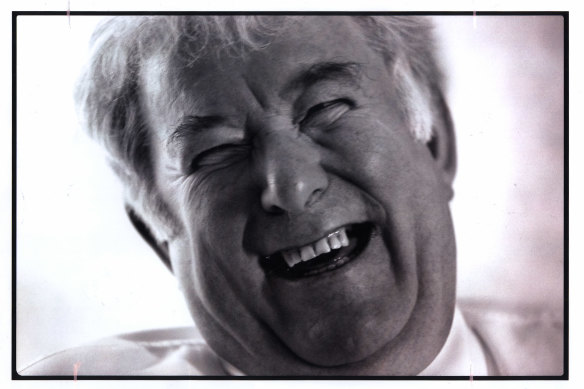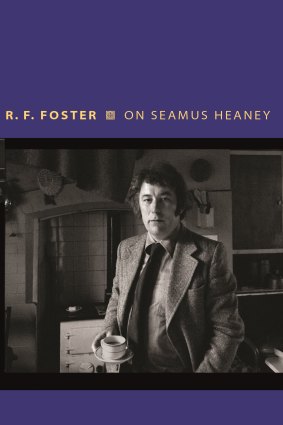- REVIEW
- Culture
- Books
- Literature
This was published 3 years ago
The gentle quietness in the art of Seamus Heaney
By Peter Craven
POETRY
On Seamus Heaney
Roy Foster
Princeton University Press, $34.99
You need only glance at Roy Foster’s biography of W.B. Yeats to realise he is a biographer of the first rank, embedding literature and its makers in the rolling span of historical time. Now he has written a biography of Seamus Heaney, arguably the most celebrated Irish poet since Yeats, and he makes it clear he’s a fan.
He remembers where he was sitting when he read his first Heaney poem in 1978 and the tears that came into his eyes then. And he remembers being enthralled by another poem, 20 years later, that appeared in The New Yorker, the clipping of which, growing yellow, sat on the wall of his Oxford study for the best part of the next 20 years.

There is a deep sanity and suavity in the poetry of Seamus Heaney, seen here during a visit to the Melbourne Writers Festival in 1994.Credit: Dominic O'Brien
This is a dutiful book as well as a labour of love and in it the great biographer shows his reverence both for the accomplishment of Heaney’s work and its deep sanity and suavity. From Death of a Naturalist in 1966 it was clear that Heaney’s poetry with its muted beauty of form and its pensiveness was the body of work many would see as the supreme poetry of the age, partly because it was not shouting for supremacies.
Think of Strange Fruit about the preserved body of the girl executed so long ago in history that it might almost be before the beginning of time yet the vicissitudes of time have somehow preserved her like the embalmed remnant of the injustice of the world. Think, too, of that anthology piece Tollund Man: ‘‘Someday I will go to Aarhus / to see his peat-brown head / the mild pods of his eyelids / his pointed skin-cap.’’
Heaney, a Catholic Irishman in what by the late ’60s was the inflamed North, was intensely aware of the pressure in a land that loves poetry as a lineal right to declare himself – with a Yeatsian intensity and bravura – for the oppressed Catholic cause.

Credit:
In practice, he was temperamentally and intellectually unsuited to any such grandstanding, though the poems in his ’70s collections – Wintering Out, North and Field Work – have a tremendous pondered dignity and deliberation as this man of Trinitarian theology and national identifications does his damnedest to indicate how seriously he takes a political situation he doesn’t want to be rhetorical about.
He was published, early on, by the greatest literary editor of his generation, Karl Miller, in his halcyon days at The London Review of Books. And Heaney was hailed by the great Robert Lowell, though he seems to have known that he had a greater affinity for the quietude of Elizabeth Bishop’s poetry. He was in the most formidable sense ‘‘a university man hankering after order in a disjointed time’’.
It’s significant that he translated Beowulf and that he did a version of the late almost-romance-like play by Sophocles, The Philoctetes, almost purgatorial in its muted hopeful tone, not quite a paradigm for divided loyalties but perhaps for shared understandings. He called it The Cure at Troy and Joe Biden has frequently quoted from it in his campaigns.
Throughout Heaney’s work, but especially in the later books, Dante is a palpable model, and there are moments when he confronts that formidable shade James Joyce, a man who refused to accept any substitute for Catholicism even though he could not kneel down to it. The Haw Lantern is full of the poignancy of poems about his sense of the loss of his mother and shows the power Heaney’s understatements can elicit.
Heaney is arguably the most formidable example of the phenomenon of the poet-professor. It was a role he performed with great grace and seriousness even if there is something just a bit surprising about the fact that he won the Nobel Prize for Literature in 1995, not least when you consider that his Irish predecessors were Yeats and Beckett.
Heaney was a friend of the Melbourne academic poets, Vincent Buckley and Chris Wallace-Crabbe, and if you want to say his poetry was greater than theirs it might be more difficult to suggest that it was of a wholly different order.
I sometimes feel with Heaney the way Robert Hughes felt about Cezanne: is there something here that I just don’t get, and it’s my fault? He doesn’t seem to me to have the magnetising, mesmerising quality Les Murray had, nor do I hear in his poetry that reverberating tragic quality of the greatest Peter Porter, for my money the best poet of that generation, ‘‘the fire will come out of the sun / And I will look into the heart of it’’.
But Heaney was a good poet and he seems to have been a lovely man. Foster’s gifts, which might do justice to a Joyce or a Beckett, were not needed for this careful and attentive poetic biography but he uses them with loving care, with great concentration and economy.